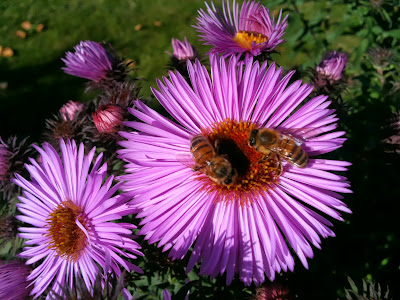One interesting thing I observed yesterday; I saw a honeybee on a Solidago plant! Solidago was flowering very strong all the summer and I could not see even one honey bee on its flowers only hover flies. Now I saw one plant with a few honeybees working its flowers :) I don't think honeybees like this flower that much but now there is little to be found in the nature so they are using all they can find.
Natural Beekeeping
Top Bar ApiRevolution has begun! Lets make some inexpensive Top Bar Hives and let them be pesticide free on their own natural comb! Che Guebee is a rebel bee fighting for the survival of the Biodiversity we all depend on and which is seriously endangered by deforestation and mono-crop agriculture! What kind of teaching have you got if you exclude nature?
Monday, September 30, 2013
Aster; The Autumn Star
One interesting thing I observed yesterday; I saw a honeybee on a Solidago plant! Solidago was flowering very strong all the summer and I could not see even one honey bee on its flowers only hover flies. Now I saw one plant with a few honeybees working its flowers :) I don't think honeybees like this flower that much but now there is little to be found in the nature so they are using all they can find.
Subscribe to:
Post Comments (Atom)







The Hover flies are very important to. They put theirs eggs in the aphids colony and are on place already in early spring. They prefer the Apiaceae family. I sow a lot of extra dill so they have a lot of flowers in late summer and autumn.
ReplyDeleteThe two keywords are biodiversity and no tilling in organic gardening. This will get the gardener a lot of insectpredators which helps with the varmints. A lot of them are hiding in the ground therefor no tilling. You have the ground-beetles, hemipterons spiders and of course the earwigs and many more. They are all living in the ground at least during the winter.
One tip for the autumn pollencollectors is the honeysuckles. They have lots of very good flowers and have one of the nicest smell in the world. I have one next to the frontdoor and I love it. I can still hear the bees just opening the door, very loudly :-)
I will focus on planting Jättebalsamin alot. It is blooming now and bees love it :) Im not sure if Jättebalsamin can grow in your zone.
DeleteI agree about biodiversity and no-tilling farming.
Which honey sucle are you refering to? (Latin name).
I refer to the "Höstkaprifol". In the list some of them say that it flowers from juli to oktober and in other list they say juni-juli. My is still flowering and will do a little untill middle of oktober at least.
DeleteMy deliver of plants have Lonicera periclymenum 'Serotina' and says that it flowers from juli-oktober but in another plantlist they say juni-juli. I think my deliver is more proffesional :-)
I have some variant of Lonicera periclymenum and there must be specialists to reach the nectar but pollen are for bees and bumblebees.
I have it outside the kitchen window precisely until the birdfeeders and its a very good protection for them during winter.
I have to cut it down in next spring else it wouldnt flower so much but it will reach severel meters hight in one season after cutdown when its established.
Are you sure about the balsamin. Ive got it in my garden and it was very invasive but then I get geese it disappear.
Deletehttp://www.biodiverse.se/articles/jattebalsamin-harlig-tradgardsvaxt-eller-aggressiv-invasionsart
Of course Balsamin can grow up there :) it comes from Himalaya where it is very cold. I dont feel I nor bees have the luxury of calling balsamin invasive in this damaged eco system. You live in an area with lots of good forage for bees. I too am in a good area in north of skåne but most of the world is not that fortunate there where mono crop fields dominate.
DeleteI can see how the lupin force the local flora out of their way and think Balsamin will do the same.
DeleteIts a big problem here with all the lupin because the ditches along the roads are one of the last places for the flora from the meadows. It´s a lot of areas which are ditches and it could be important for the biodiversity
Phil Chandler reports that balsamin in his area has established itself to one area and is not behaving invasive. Thanks to Balsamine and Ivy their bees have a honey flow now and most of the natural beekeepers dont feed syrup thanjs to this flow.
DeleteBut I understand yoyr concern.
Why I start commenting was for saying that your pictures are really nice but I was captured by the insects and flowers :-)
ReplyDeleteInteresting :-)
ReplyDeleteThe bees are really full of pollen all over their bodies then they go to balsamin. I have a new beekeeper I support in Sunne. She was worried about any disease then the bees were grey/white over the body but its then they went inside the balsamin and get pollen all over their bodies. I think the housebees take care of that pollen as well as the pollen on the legs.